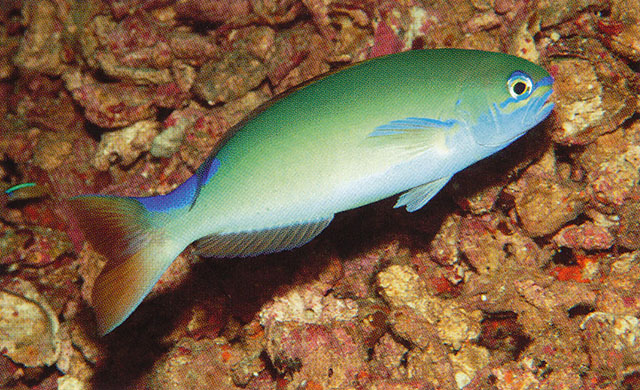| Malacanthidae (Tilefishes) |
| 15.43 cm SL (male/unsexed) |
|
reef-associated; marine; depth range 30 - 85 m |
| Indo West Pacific: Indonesia, Philipines, Palau, Yap Is. and the Solomon Islands. |
|
Dorsal spines (total): 10-10; Dorsal soft rays (total): 13-13; Anal spines: 2-2; Anal soft rays: 12-12; Vertebrae: 24-24. This species is distinguished by the following characters: D X,13; A II,12; pectoral rays 17; total gill rakers on first branchial arch 27-29; pored lateral line scales 84-92 with 98-120 scales in lateral series above lateral line; preopercular serrae 16-23; greatest body depth 3.4-3.9 in SL; length of last dorsal spine 2.5-3.0 in HL; longest soft dorsal ray 1.1-1.4 in HL; colour in life mainly greenish (darker dorsally), shading to light blue on lower head, thorax, and abdomen; caudal peduncle with an elongate sky aqua-blue saddle-like spot dorsally; narrow sky-blue band from front of snout to lower edge of eye; lips mainly blue; narrow yellow-orange band just below blue band, passing just under eye to posterior margin of preoperculum; dorsal and anal fins pale yellow with pink margin; caudal fin reddish with indistinct central pale streak, the upper and lower margins narrowly light blue to pinkish; pectoral fins mainly translucent except upper 4-5 rays blue; pelvic fins bluish white; iris yellow with bright blue streak dorsally and ventrally (Ref. 85568). |
| Inhabits gentle rubble slopes; constructs impressive rubble mounds over its burrows, which range from about 50-70 cm in height and 1.5-2 m in diameter and typically, the fish are seen hovering a short distance from their home mound, with up to six individuals using a single mound. The fish when approached closely or frightened by spear shots, quickly retreat
into the burrow, which is located near the apex of the mound (Ref. 85568). |
|
Not Evaluated (N.E.) Ref. (130435)
|
| harmless |
Source and more info: www.fishbase.org. For personal, classroom, and other internal use only. Not for publication.
